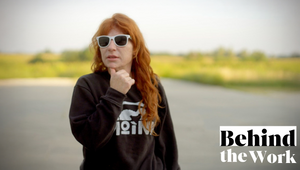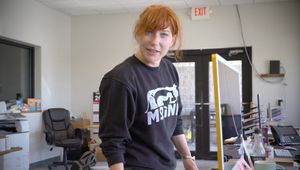
Director’s Playbook: Winning Treatments

Seasoned director, Jordan Brady, crossed paths with Kristyna Archer eight years ago when she was awarded the Filmmaker Diversity Award to attend his Commercial Directing Bootcamp. Since then, they’ve kept their relationship going. Nearly a decade later, Kristyna still calls Jordan her ‘mentor’, and Jordan calls her ‘fantastic’ – it seems to me that it's a relationship steeped in shared passion and mutual respect. Nowadays, Kristyna is an esteemed director, and has become a mentor to many herself, teaching her own courses.
In part one of the Director’s Playbook series, Jordan shared his 11 holy grail tactics for winning pitches. Today, he and Kristina take on our next topic: how to write a winning treatment. Here, we’re gifted an invaluable dual perspective on the art of treatment writing. In this interview, we’ll start with the bare bones, then add the meat and muscle – exploring starting points, processes, techniques, do’s, don’ts, and real world experiences.
Through Jordan and Kristyna’s insights, we unmask these crucial documents – how they shape narratives, help align creative visions, and ultimately, clinch converted projects.

Pictured above: Kristyna Archer on set
LBB> What, in your words, is a director's treatment?
Jordan> The treatment is primarily a sales tool, a chance to recap your pitch call and really lay out how you see the spot. Those ever-savvy Canadians do the briefing call and then you go off and write a treatment. So it's more crucial to really communicate your vision with the written word.
It’s a means to another means.
Kristyna> A visionary solution to a creative problem or idea. A roadmap.
LBB> What’s your usual process? Any unique approaches?
Jordan> We record the call, and I’ve been using a transcription service for years. Now, it’s otter.ai, but AI cannot be trusted entirely because it’s a bold-faced liar. So I use it to jump to key parts of the conversation.
Honestly, I stress too much over the cover image before even writing; which is a way to justify not writing. A trip to the brand’s webpage and Pinterest/Instagram informs me too.
I suck at Midjourney, but Adobe Firefly combined with stock photos is helping me create images.
Kristyna> I start to map out and write down all the ideas and references that first flood my mind after a creative call, with no regard for grammar or clarity. Then I go through my curated library and look for any blind spots of what I might be missing that I could add into the spot so every single frame is epic.
LBB> Why do they matter?
Jordan> Treatments allow the agency – and increasingly they’ll share with the client – to compare approaches. If we agree that the pitch call is a vibe-check and testing your initial approach, then the treatment is committing in writing what you’ll do.
I rarely share the entire treatment with my crew, because let’s be real, they won’t read beyond their department. So I send the pertinent pages to them when the job is awarded.
Kristyna> There's a reason why people say there are too many cooks in the kitchen. Without a director's treatment, there's a risk of creative chaos. Different departments may interpret the project differently, which will muddy the idea, and lead to inconsistencies in the core concept.
LBB> How long in your opinion, should you spend on a treatment, (depending of course on the length of the production)?
Jordan> Once I’ve toiled over the cover, fixed a snack, and taken a bike ride, I can whip out the words in a few hours. Then I let it marinate overnight and redo the lame images and stress over the visual presentation. I find it’s quicker to do a layout myself but sometimes hire a more talented layout visual artisan. But I’ve written my own for years.
Regarding the overall length of the final document, for a few comedy dialogue spots, I aim for 12 to 25 pages, with pages of full photos.
Kristyna> The length of the treatment should be as long as it needs to express your vision and speak to the core of the campaign. If you're seasoned, your confidence comes through in your ability to be concise. Often if you're starting out, you think more is better; you go on all these tangents suggesting every possible idea, but then it lacks clarity and direction (literally what they are coming to you for).
What you think is helping you is hurting you and you can lose everybody along the way. I would say 25-30 pages is a sweet spot, but yes, depending on the size and scale of the campaign. If you can express the idea in 10, do it!
LBB> Where is the best place to start?
Jordan> I start the treatment process with copy/pasting shit from a prior winning treatment. I wish I were joking.
Kristyna> Before the call, research the brand. Read the brief thoroughly. You want to be prepared with questions for the call. If you have a clear point of view going into the call, you can nudge that with ideas and questions, and their responses will help inform you on what might work best for this creative.
LBB> An example of when a treatment has helped you win the project
Jordan> After a zoom, when it felt like many were distracted and the ECD “had to jump off” the treatment led to a follow-up call with the ECD and we won the job.
Kristyna> I mean, I don't remember a time when a treatment didn't help me win a job in the event of a triple bid. Is this a trick question? ;)
LBB> An example of when a bad treatment has cost you one (if at all)
Jordan> I turned in a B- looking, not as shiny treatment after an A++ call, that I designed a treatment myself. We were bidding against a talented director and large production factory. In hindsight, I should have supported the cottage industry of treatment-makers and hired out for visuals and layout, but time was of the essence. My silly self thought the words would do the heavy-lifting.
Of note, the winning director is extremely talented and this example is conjecture on my part. Perhaps she turned in a hand-scribbled treatment on a bar napkin. We’ll never know.
Kristyna> I never intentionally make a bad treatment per say. So again, is this a trick question? I don't know if it's a conversation about 'good or bad' versus the strategy and the approach you chose to put forth as the best approach in your mind. That might not align with what the creatives have in their mind. In that case it wasn't meant to be if from the get-go since you're viewing things from opposite angles and can't align. Yet when you do pitch your new perspective and fresh vision to the campaign, it can breathe new life into it that they didn't even see before, and has the ability to completely pivot a campaign.
LBB> What 3 Do’s would you advise?
Jordan:
1. Write it yourself but have someone proofread that knows nothing about the gig.
2. Always say, “Our casting is crucial” as if on some jobs it is not.
3. The agency will ask for a PDF so make sure your words work without the funny GIF of Dwight from “The Office” making that face to camera.
Kristyna:
1. Do make it personal and establish your unique connection to the brand.
2. Do use your authentic voice, be concise, have a clear and strong point of view and take some risks.
3. Do navigate the subtle art of addition.
LBB> And 3 Don'ts?
Jordan:
1. Don’t be afraid to use the words 'premium ' and ‘cinematic’.
2. Don’t include elaborate storyboards or agencies will expect all of us to include them.
3. Avoid using “maybe…”
Kristyna:
1. Don't be indecisive.
2. Don't just repeat back what their spot is.
3. Don't belabour the point.
LBB> Anything else you'd like to add?
Jordan> I feel privileged to be asked to pitch; that I even get to write a treatment which means I have a seat at the table. Even with repeat clients and single-bid situations, I’ll write up a mini-treatment to keep us, literally, on the same page. It’s a springboard to our success.
At the end of the day, I think your reel lands the job, and the treatment is a chance to seal the deal.
Kristyna Archer’s Winning Director Treatments course is excellent and really hits all the points. I, too, have a Director’s Treatments Unmasked course that comes bundled with How To Pitch and a consultation call.
Kristyna> An industry-wide discussion on compensation and equality is a critical topic that's burgeoning to the surface. Some disruptors leading the way are the incredible team at the Pitch Positive Pledge. From the get-go the pitch process is not a level playing field. Small shops and freelance directors face greater challenges in developing treatments compared to massive production companies with extensive design teams. I hope that agency creatives can focus on the ideas presented in the treatment despite these unequal bidding circumstances.
I've created a course called Winning Director Treatments to help mentor underrepresented talent and level the playing field and also a podcast aiming to create more transparency in the pitch process called The Treatment Forum that I hope becomes a resource that demystifies treatments from all sides. You can listen here.















